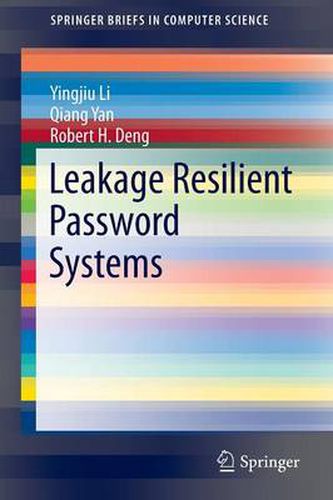Readings Newsletter
Become a Readings Member to make your shopping experience even easier.
Sign in or sign up for free!
You’re not far away from qualifying for FREE standard shipping within Australia
You’ve qualified for FREE standard shipping within Australia
The cart is loading…






This title is printed to order. This book may have been self-published. If so, we cannot guarantee the quality of the content. In the main most books will have gone through the editing process however some may not. We therefore suggest that you be aware of this before ordering this book. If in doubt check either the author or publisher’s details as we are unable to accept any returns unless they are faulty. Please contact us if you have any questions.
This book investigates tradeoff between security and usability in designing leakage resilient password systems (LRP) and introduces two practical LRP systems named Cover Pad and ShadowKey. It demonstrates that existing LRP systems are subject to both brute force attacks and statistical attacks and that these attacks cannot be effectively mitigated without sacrificing the usability of LRP systems. Quantitative analysis proves that a secure LRP system in practical settings imposes a considerable amount of cognitive workload unless certain secure channels are involved. The book introduces a secure and practical LRP system, named Cover Pad, for password entry on touch-screen mobile devices. Cover Pad leverages a temporary secure channel between a user and a touch screen which can be easily realized by placing a hand shielding gesture on the touch screen. The temporary secure channel is used to deliver a hidden message to the user for transforming each password symbol before entering it on the touch screen. A user study shows the impact of these testing conditions on the users’ performance in practice. Finally, this book introduces a new LRP system named ShadowKey. Shadow Key is designed to achieve better usability for leakage resilient password entry. It leverages either a permanent secure channel, which naturally exists between a user and the display unit of certain mobile devices, or a temporary secure channel, which can be easily realized between a user and a touch screen with a hand-shielding gesture. The secure channel protects the mappings between original password symbols and associated random symbols. Unlike previous LRP system users, Shadow Key users do not need to remember anything except their passwords. Leakage Resilient Password Systems is designed for professionals working in the security industry. Advanced-level students studying computer science and electrical engineering will find this brief full of useful material.
$9.00 standard shipping within Australia
FREE standard shipping within Australia for orders over $100.00
Express & International shipping calculated at checkout
This title is printed to order. This book may have been self-published. If so, we cannot guarantee the quality of the content. In the main most books will have gone through the editing process however some may not. We therefore suggest that you be aware of this before ordering this book. If in doubt check either the author or publisher’s details as we are unable to accept any returns unless they are faulty. Please contact us if you have any questions.
This book investigates tradeoff between security and usability in designing leakage resilient password systems (LRP) and introduces two practical LRP systems named Cover Pad and ShadowKey. It demonstrates that existing LRP systems are subject to both brute force attacks and statistical attacks and that these attacks cannot be effectively mitigated without sacrificing the usability of LRP systems. Quantitative analysis proves that a secure LRP system in practical settings imposes a considerable amount of cognitive workload unless certain secure channels are involved. The book introduces a secure and practical LRP system, named Cover Pad, for password entry on touch-screen mobile devices. Cover Pad leverages a temporary secure channel between a user and a touch screen which can be easily realized by placing a hand shielding gesture on the touch screen. The temporary secure channel is used to deliver a hidden message to the user for transforming each password symbol before entering it on the touch screen. A user study shows the impact of these testing conditions on the users’ performance in practice. Finally, this book introduces a new LRP system named ShadowKey. Shadow Key is designed to achieve better usability for leakage resilient password entry. It leverages either a permanent secure channel, which naturally exists between a user and the display unit of certain mobile devices, or a temporary secure channel, which can be easily realized between a user and a touch screen with a hand-shielding gesture. The secure channel protects the mappings between original password symbols and associated random symbols. Unlike previous LRP system users, Shadow Key users do not need to remember anything except their passwords. Leakage Resilient Password Systems is designed for professionals working in the security industry. Advanced-level students studying computer science and electrical engineering will find this brief full of useful material.